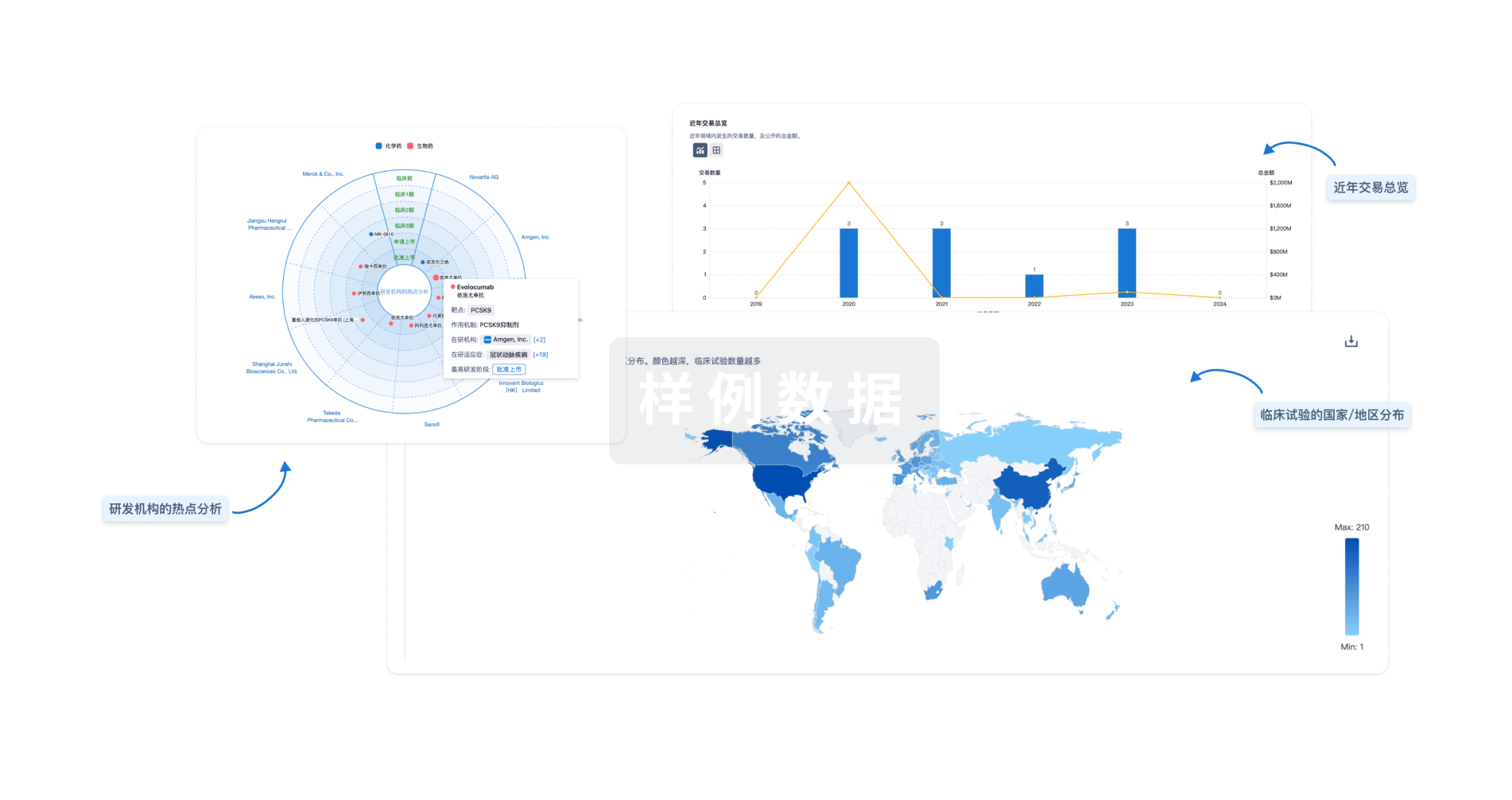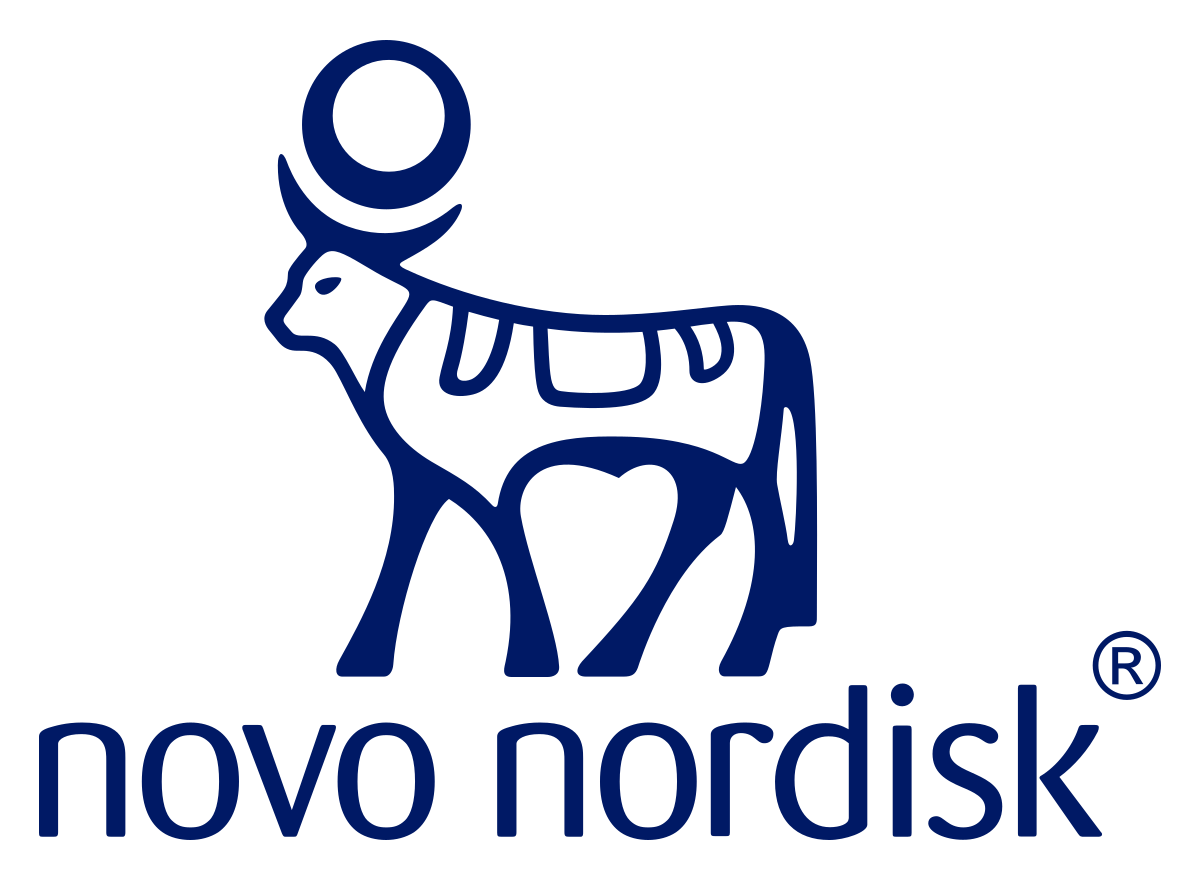预约演示
更新于:2025-05-07
BACH1
更新于:2025-05-07
基本信息
别名 BACH-1、BACH1、BTB and CNC homolog 1 + [5] |
简介 Transcriptional regulator that acts as a repressor or activator, depending on the context. Binds to NF-E2 DNA binding sites. Plays important roles in coordinating transcription activation and repression by MAFK (By similarity). Together with MAF, represses the transcription of genes under the control of the NFE2L2 oxidative stress pathway (PubMed:24035498). |
关联
5
项与 BACH1 相关的药物作用机制 BACH1抑制剂 [+1] |
在研适应症 |
非在研适应症- |
最高研发阶段临床1期 |
首次获批国家/地区- |
首次获批日期1800-01-20 |
靶点 |
作用机制 BACH1抑制剂 |
在研机构 |
在研适应症 |
非在研适应症- |
最高研发阶段临床前 |
首次获批国家/地区- |
首次获批日期1800-01-20 |
WO2022133970
专利挖掘靶点 |
作用机制- |
非在研适应症- |
最高研发阶段药物发现 |
首次获批国家/地区- |
首次获批日期1800-01-20 |
1
项与 BACH1 相关的临床试验NCT05167526
A Phase 1 Combined Single and Multiple Ascending Oral Dose Study to Evaluate the Safety, Tolerability, Pharmacokinetics and Pharmacodynamics of ASP8731 in Healthy Adult Participants, Including an Assessment of a Food Effect
ASP8731 is a potential new treatment for people with sickle cell disease. Before ASP8731 is available as a treatment, the researchers need to understand how it is processed by and acts upon the body. They do this to find a suitable dose and to check for potential medical problems from the treatment. This type of study usually includes healthy adults but can include people with the relevant condition.
The main aim of this study is to learn if healthy adults have any medical problems after taking different doses of ASP8731.
This study will be in 2 parts.
In Part 1, different small groups of people will take lower to higher doses of ASP8731 or a placebo. In this study a placebo looks like ASP8731 but will not have any medicine in it. This is done to find suitable doses of ASP8731 and work out how often it should be taken. Some of this information will be used in Part 2 of the study. The first group will take the lowest dose of ASP8731 or the placebo. A medical expert panel will check the results from this group and decide which ASP8731 dose the next group can take. The panel will do this for each group until all groups have taken ASP8731 or until a suitable dose of ASP8731 has been reached.
In Part 1, people will visit the study clinic 4 times. The first visit is to check if they can take part. People will be asked about their medical history, have a physical exam, and their vital signs checked (pulse rate, temperature, and blood pressure). Also, they will have an ECG to check their heart rhythm and have some blood samples taken for laboratory tests. For women this will include a pregnancy test.
At the second visit, people will stay in the study clinic for a few days. In most groups, people will be picked to take either ASP8731 or the placebo by chance alone. They will fast before taking ASP8731 or the placebo. 1 group will take ASP8731 with food. No-one in that group will take the placebo. After taking ASP8731 or the placebo (or just ASP8731 with food), people in all groups will give blood and urine samples during the next 3 days. Also, they will be checked for any medical problems during their clinic stay.
People will return to the study clinic for a 2 follow-up visits - at about 8 and 30 days after they last took ASP8731 or the placebo. At these visits people will be asked if they have any medical problems. They will have a physical exam, have their vital signs checked (pulse rate, temperature, and blood pressure), and have some blood samples taken for laboratory tests. For women, this will include another pregnancy test.
In Part 2, other different small groups of people will take lower to higher doses of ASP8731 or a placebo. How often it is taken will be worked out from Part 1.The first group will take the lowest dose of ASP8731 or the placebo each day over several days. A medical expert panel will check the results from this group and decide which ASP8731 dose the next group can take. The panel will do this for each group until all groups have taken ASP8731.
In Part 2, people will visit the study clinic 5 times. The first visit is to check if they can take part. People will be asked about their medical history, have a physical exam, and their vital signs checked. Also, they will have an ECG and have some blood samples taken for laboratory tests. For women this will include a pregnancy test.
At the second visit, people will stay in the study clinic for several days. In all groups, people will be picked to take either ASP8731 or the placebo by chance alone. After taking ASP8731 or the placebo, people in all groups will give blood samples throughout their stay. They will give urine samples during the last few days of their stay. Also, they will be checked for any medical problems during their clinic stay. After discharge, people will return to the clinic 4 days later for a third visit. At this visit, they will have some blood samples taken for laboratory tests. Also, they will have their vital signs checked and will be asked if they have any medical problems.
People will return to the study clinic for a 2 follow-up visits - at about 15 and 30 days after they last took ASP8731 or the placebo. At these visits people will be asked if they have any medical problems. They will have a physical exam and have their vital signs checked. They will also have an ECG and have some blood samples taken for laboratory tests. For women, this will include another pregnancy test.
No other visits are planned during this study.
The main aim of this study is to learn if healthy adults have any medical problems after taking different doses of ASP8731.
This study will be in 2 parts.
In Part 1, different small groups of people will take lower to higher doses of ASP8731 or a placebo. In this study a placebo looks like ASP8731 but will not have any medicine in it. This is done to find suitable doses of ASP8731 and work out how often it should be taken. Some of this information will be used in Part 2 of the study. The first group will take the lowest dose of ASP8731 or the placebo. A medical expert panel will check the results from this group and decide which ASP8731 dose the next group can take. The panel will do this for each group until all groups have taken ASP8731 or until a suitable dose of ASP8731 has been reached.
In Part 1, people will visit the study clinic 4 times. The first visit is to check if they can take part. People will be asked about their medical history, have a physical exam, and their vital signs checked (pulse rate, temperature, and blood pressure). Also, they will have an ECG to check their heart rhythm and have some blood samples taken for laboratory tests. For women this will include a pregnancy test.
At the second visit, people will stay in the study clinic for a few days. In most groups, people will be picked to take either ASP8731 or the placebo by chance alone. They will fast before taking ASP8731 or the placebo. 1 group will take ASP8731 with food. No-one in that group will take the placebo. After taking ASP8731 or the placebo (or just ASP8731 with food), people in all groups will give blood and urine samples during the next 3 days. Also, they will be checked for any medical problems during their clinic stay.
People will return to the study clinic for a 2 follow-up visits - at about 8 and 30 days after they last took ASP8731 or the placebo. At these visits people will be asked if they have any medical problems. They will have a physical exam, have their vital signs checked (pulse rate, temperature, and blood pressure), and have some blood samples taken for laboratory tests. For women, this will include another pregnancy test.
In Part 2, other different small groups of people will take lower to higher doses of ASP8731 or a placebo. How often it is taken will be worked out from Part 1.The first group will take the lowest dose of ASP8731 or the placebo each day over several days. A medical expert panel will check the results from this group and decide which ASP8731 dose the next group can take. The panel will do this for each group until all groups have taken ASP8731.
In Part 2, people will visit the study clinic 5 times. The first visit is to check if they can take part. People will be asked about their medical history, have a physical exam, and their vital signs checked. Also, they will have an ECG and have some blood samples taken for laboratory tests. For women this will include a pregnancy test.
At the second visit, people will stay in the study clinic for several days. In all groups, people will be picked to take either ASP8731 or the placebo by chance alone. After taking ASP8731 or the placebo, people in all groups will give blood samples throughout their stay. They will give urine samples during the last few days of their stay. Also, they will be checked for any medical problems during their clinic stay. After discharge, people will return to the clinic 4 days later for a third visit. At this visit, they will have some blood samples taken for laboratory tests. Also, they will have their vital signs checked and will be asked if they have any medical problems.
People will return to the study clinic for a 2 follow-up visits - at about 15 and 30 days after they last took ASP8731 or the placebo. At these visits people will be asked if they have any medical problems. They will have a physical exam and have their vital signs checked. They will also have an ECG and have some blood samples taken for laboratory tests. For women, this will include another pregnancy test.
No other visits are planned during this study.
开始日期2022-03-07 |
100 项与 BACH1 相关的临床结果
登录后查看更多信息
100 项与 BACH1 相关的转化医学
登录后查看更多信息
0 项与 BACH1 相关的专利(医药)
登录后查看更多信息
750
项与 BACH1 相关的文献(医药)2025-08-01·Tissue and Cell
The interplay of sleep deprivation, ferroptosis, and BACH1 in cardiovascular disease pathogenesis
Article
作者: Wu, Zhenghua ; Lu, Xinglong ; Huang, Xuanxuan ; Cao, Yin
2025-07-01·European Journal of Pharmacology
Netrin-1 binding to UNC5b improves post-stroke neuronal ferroptosis via AMPK-BACH1 pathway
Article
作者: Yu, Jian ; Liao, Songjie ; Luo, Ying ; Wang, Rui ; Yao, Meiling
2025-07-01·Experimental Neurology
Gastrodin alleviates Aβ25–35-induced glycolytic dysfunction via activating PI3K/AKT/BACH1 signaling in Alzheimer's disease models
Article
作者: Lei, Hui-Ping ; Liu, Ting-Ting ; Wu, Ling-Nan ; Liu, Ju ; Jin, Hai ; Hu, Yue-Ting ; Jin, Feng ; Shi, Jing-Shan ; Ji, Xin-Hao ; Zhou, Shao-Yu ; Yang, Xue ; Wei, Ai-Hong
26
项与 BACH1 相关的新闻(医药)2025-04-20
·学术经纬
自1979年被发现以来,p53蛋白已成为了研究最为广泛和深入的肿瘤抑制因子之一。作为转录因子,p53调控众多下游信号通路,诱导细胞周期停滞、细胞凋亡和衰老是其最“经典”的功能,也被认为是其清除受损细胞、防止癌细胞发生的主要手段。学术经纬相关阅读:人类天生拥有的肿瘤克星!《细胞》子刊:45年来,我们对p53了解有多少?然而随着研究的深入,除了细胞凋亡(apoptosis)外,还有多种新发现的程序性细胞死亡方式,比如铁死亡(ferroptosis)、坏死性凋亡(necroptosis)、焦亡(pyroptosis)等,同样有p53的参与。并且,p53对这些“非凋亡性细胞死亡(以下简称NACD)通路”的调控,可能在正常的生理活动以及癌症发展、感染、炎症和神经退行性疾病中也发挥了重要作用。▲除了凋亡外,近年发现了多种程序性细胞死亡方式(图片来源:参考资料[1])近日,哥伦比亚大学顾伟教授、Brent Stockwell教授,以及纪念斯隆-凯特琳癌症中心的姜学军教授在Nature reviews molecular cell biology杂志上合作发表综述,为我们总结了p53蛋白作为“多面手”调控NACD的机制及其在疾病中的重要性,为将来靶向p53调控的NACD通路开发疾病新疗法指出了研究方向。铁死亡与p53铁死亡是一种由铁依赖性的脂质过氧化导致的细胞死亡类型,与癌症、衰老、缺血性器官损伤、神经退行性变性疾病等有广泛的关联,近十年得到了深入研究,有重要的生物医学意义。值得一提的是,最早提出“铁死亡”概念的正是本篇综述的作者之一Brent Stockwell教授。细胞发生铁死亡有赖于三个要素:脂质过氧化的底物(多不饱和脂肪酸)、脂质过氧化的执行者(活化氧ROS、铁、脂氧合酶)以及抗铁死亡系统(谷胱甘肽、GPX4、等)。p53对这三个要素都可能产生影响,进而调控铁死亡。例如,p53调节多种脂质代谢途径,通过增加多不饱和脂肪酸在细胞膜磷脂中的比例,使细胞更易发生铁死亡。p53还会通过激活GLS2(谷氨酰胺酶2)的表达而增加ROS的产生,上调TfR1(转铁蛋白受体1)来促进线粒体对铁的摄取,从而促使铁死亡发生。此外,研究者在2015年首次发现p53会抑制谷胱甘肽(GSH)合成过程所需的关键因子胱氨酸/谷氨酸转运体SLC7A11的转录,进而引起谷胱甘肽过氧化物酶4(GPX4)活性下降,导致脂质过氧化积累,引发铁死亡。同时,p53对SLC7A11的抑制还会释放脂氧合酶的活性,引发磷脂过氧化,以不依赖GPX4的方式增强铁死亡。▲p53通过多种方式影响铁死亡不同环节,从而促进或抑制铁死亡(图片来源:参考资料[1])值得注意的是p53具有“双面性”:虽然被广泛认为诱导铁死亡的发生,但它也会在特定情况下抑制铁死亡。例如,在纤维肉瘤细胞中,p53诱导细胞周期抑制蛋白p21延缓铁死亡,推测是一种营养胁迫下的保护机制。在结直肠癌细胞中,p53被发现会阻止DPP4与NOX1相互作用,从而抑制这一信号通路介导的铁死亡。而在肝癌细胞中,p53通过诱导磷脂转移蛋白PLTP表达促进脂滴生成,将易氧化的脂质底物隔离,也会降低铁死亡的敏感性。这些发现与实验中使用的不同癌症类型和铁死亡诱导方法有关,同时也反映了p53在维持组织稳态、防止肿瘤发生中具有的“生死平衡”特性。作为人类癌症中突变最频繁的一个基因,p53突变几乎出现在一半的癌症中。已有的研究显示,癌症中常见的一些p53突变体不仅会削弱p53诱导铁死亡的能力,甚至会获得抑制铁死亡的新功能。例如常见的R175H突变,导致p53结合BACH1,从而解除BACH1对SLC7A11的抑制,减少铁死亡。此外在三阴性乳腺癌模型中,R175H和R248W突变体上调两种抗氧化蛋白抑制脂质过氧化,从而保护癌细胞避免铁死亡;敲除这两种突变体的实验显示肿瘤消退,提示靶向p53突变体可能为治疗三阴性乳腺癌提供有效方法。坏死性凋亡与p53坏死性凋亡在2005年由袁均瑛教授团队率先提出,是介于程序性细胞凋亡与细胞坏死(cell necrosis)之间的一种细胞死亡通路,往往在凋亡不能发生时启动,在炎症、感染、组织损伤以及癌症中发挥作用。激酶RIPK1及其下游蛋白RIPK3与MLKL是这条通路中的关键因子。▲p53调控坏死性凋亡(图片来源:参考资料[1])同样地,p53通过多种方式机制推动细胞在凋亡被阻断时“切换”到坏死性凋亡。例如,p53可以作为“基因开关”打开长链非编码RNA(lncRNA)NRF,调节miRNA,进而解除RIPK1/RIPK3受到的抑制,促进坏死性凋亡,在心肌缺血损伤模型中导致心肌细胞死亡。而在用化疗药物5-氟尿嘧啶(5-FU)处理结直肠癌细胞时,促凋亡分子PUMA在被p53激活后,促进线粒体DNA释放到细胞质中,进而启动ZBP1-RIPK3通路介导的坏死性凋亡,这条通路能够增强抗肿瘤免疫反应。在p53介导的坏死性凋亡中,线粒体是重要一环。在急性胰腺炎中,p53通过下调过氧化物还原酶等,导致线粒体ROS积累,促进坏死性凋亡。线粒体ROS还会驱动p53向线粒体转移并招募CypD(亲环蛋白D),从而打开线粒体“死亡通道”mPTP,导致坏死性凋亡。并且,p53对线粒体的破坏作用会形成“恶性循环”,即ROS越多,p53越活跃,线粒体损伤越严重,最终执行清除细胞的任务。而p53调控的坏死性凋亡受到表观遗传等多种因素的影响。例如在乳腺癌细胞中,组蛋白甲基转移酶G9a的缺失会导致p53依赖性坏死性凋亡增加,抑制肿瘤复发。在视网膜变性中,p53诱导的坏死性凋亡会导致视锥细胞、双极神经元的缺失,这一过程能被多梳蛋白抑制复合体中的BMI1蛋白抑制。还有研究发现,在神经元缺血应激期间,死亡相关蛋白激酶DAPK1会与p53相互作用,让其同时引发凋亡和坏死性凋亡,加重脑损伤。细胞焦亡与p53细胞焦亡的概念在2001年被正式提出,信号通路由caspases和gasdermin蛋白家族介导,是由质膜打孔引发的促炎性程序性死亡,是免疫系统对抗病原菌入侵时的一种抵御手段,也是近几年肿瘤免疫治疗领域的新热点。研究p53如何响应病原体感染和炎症,以及是否可以因此激活细胞焦亡具有重要意义。但相比铁死亡和坏死性凋亡,p53在焦亡中的作用还不太明确。不过,已有的研究显示p53能够激活多种焦亡调控因子的表达,如炎症小体的传感器NLRP3、caspase-1、gasdermin蛋白家族的打孔蛋白GSDME等,且p53的缺失会阻断LPS诱导的细胞焦亡。目前的研究还发现了一些通过调节p53促进或抑制焦亡的因子。例如lncRNA MEG3能够像支架一样稳定p53,在肾癌中促进焦亡,从而抑制肿瘤。而在巨噬细胞中,去乙酰化酶SIRT1通过对p53的去乙酰化修饰抑制其活性,可阻止它激活GSDMD。此外,在被某些病原体(如利什曼原虫)感染的细胞中,BLIMP1负责抑制p53表达,这也是感染细胞能避免被焦亡清除的原因。▲p53调控细胞焦亡(图片来源:参考资料[1])(图片来源:参考资料[1])除了铁死亡、坏死性凋亡和焦亡外,这篇综述还简要探讨了p53在自噬依赖性细胞死亡、内吞性细胞死亡、PARP-1依赖性细胞死亡、副凋亡(paraptosis)、泛凋亡、铜死亡和双硫死亡中已知的调控作用。靶向p53调控的NACD与疾病治疗通过调控p53介导的铁死亡、坏死性凋亡和焦亡等NACD,科学界正在为癌症、感染性疾病、神经退行性疾病等相关疾病带来潜在的治疗选择。▲靶向p53调控的非凋亡性细胞死亡在疾病治疗中的前景(图片来源:参考资料[1])在铁死亡方面,已经发现大量药物能诱导p53介导的铁死亡,以此杀死癌细胞。例如,已经获批的抗寄生虫药物氟苯达唑(flubendazole)实现“老药新用”,通过激活p53来同时诱导铁死亡和细胞周期停滞,从而抑制去势抵抗性前列腺癌的生长。新藤黄酸(gambogenic acid)和三萜皂苷衍生物D13也能通过激活p53,分别抑制黑色素瘤转移、杀灭多药耐药性癌细胞。除了单独用药,p53激活的铁死亡也可与其他药物联合用于癌症治疗。例如,PARP抑制剂奥拉帕尼通过合成致死机制,对BRCA1/2缺陷的卵巢癌有着良好的治疗效果,但对BRCA1/2正常的肿瘤治疗效果不佳。通过与铁死亡诱导剂联用,奥拉帕尼可以通过激活p53,诱导BRCA基因表达正常的卵巢癌铁死亡。此外,磷脂酰肌醇3激酶(PI3K)和组蛋白去乙酰化酶(HDAC)双重抑制剂BEBT-908可以使p53过度乙酰化,从而促进铁死亡。在肿瘤免疫治疗中,铁死亡的诱导有助于打造促炎性肿瘤微环境,增强免疫疗法;但在病理激活的中性粒细胞内,铁死亡却会负向调控抗肿瘤免疫。因此在临床实践中,p53激活药物的癌细胞特异性递送至关重要。除了癌症领域,通过Nutlin-3激活p53调控的铁死亡机制,还有助于阻断疟原虫的肝脏感染。但作者指出,p53介导的铁死亡并不是多多益善——虽然在上述情况下有益于疾病治疗,但在正常细胞中的异常诱导可能导致器官损伤或神经退行性疾病。例如在叶酸诱导的急性肾损伤中,补充α-硫辛酸可有效抑制p53介导的铁死亡,从而减轻肾脏损伤。在阿尔茨海默病小鼠模型中,芍药苷通过直接结合p53,起到了改善认知行为的作用。在坏死性凋亡方面,靶向p53激活的坏死性凋亡对肿瘤主要起到抑制作用,有助于实现对癌细胞的清除。例如在胶质母细胞瘤中,免疫调节药物FTY720通过ROS-JNK-p53通路诱导坏死性凋亡,从而抑制肿瘤生长;在胶质瘤中,盐霉素介导p53易位至线粒体,诱导线粒体膜通透性转换孔相关的坏死性凋亡。综述指出,诱导坏死性凋亡可能对神经母细胞瘤具有新的治疗效果,后续研究需要探索能否通过激活p53调控的坏死性凋亡来清除神经母细胞瘤。但与p53激活的铁死亡类似,p53诱导的坏死性凋亡也有双面性,会对正常器官造成损害。例如,p53诱导的坏死性凋亡会加重酒精性肝病;CypD诱导的坏死性凋亡与神经退行性疾病等多种脑部疾病有关。对此,环孢菌素A等线粒体CypD-p53相互作用的抑制剂,或许有助于治疗由CypD-p53-坏死性凋亡轴引起的疾病。靶向p53调控的细胞焦亡也与多种疾病的治疗有关。在结直肠癌中,人参皂苷Rh3通过STAT3-p53-NRF2通路同时激活细胞焦亡和铁死亡,抑制癌细胞生长。另一种相关疾病是高尿酸血症性肾病,p53激活的自噬会导致细胞焦亡,进而可能引起这种疾病;3-甲基腺嘌呤自噬抑制剂则可保护肾脏免于细胞焦亡、改善高尿酸血症性肾病。此外,小分子药物CBL0137能激活p53,诱导caspase-3–GSDME依赖性细胞焦亡,从而杀死卵巢癌细胞。综合这些案例,目前已有多种针对不同病理条件下p53介导的非凋亡性细胞死亡的疗法。期待未来有更多拥有这类活性的药物问世,造福相关疾病患者。参考资料[1] Yanqing Liu et al., p53-regulated non-apoptotic cell death pathways and their relevance in cancer and other diseases. Nature Reviews Molecular Cell Biology (2025) DOI: 10.1038/s41580-025-00842-3欢迎转发到朋友圈,谢绝转载到其他平台。如有开设白名单需求,请在“学术经纬”公众号主页回复“转载”获取转载须知。其他合作需求,请联系wuxi_media@wuxiapptec.com。免责声明:本文仅作信息交流之目的,文中观点不代表药明康德立场,亦不代表药明康德支持或反对文中观点。本文也不是治疗方案推荐。如需获得治疗方案指导,请前往正规医院就诊。更多推荐点个“在看”再走吧~
2025-04-11
·生物世界
编辑丨王多鱼排版丨水成文细胞死亡是一个古老而重要的研究领域。凋亡是最早被发现的调节性细胞死亡类型,其研究已经十分充分。而近年来新的细胞死亡类型在不断被发现,并且被证明在正常生理活动或者疾病中起到关键作用。研究这些非凋亡性细胞死亡过程的调节,对于人们理解细胞死亡,以及靶向细胞死亡来治疗相关疾病有重要意义。p53 是最重要的蛋白之一,具有十分强大且广泛的作用。2025 年 4 月 9 日,哥伦比亚大学顾伟教授、Brent Stockwell 教授及纪念斯隆-凯特琳癌症中心姜学军教授联合(顾伟教授为通讯作者,顾伟教授实验室刘彦卿博士为第一作者)在 Nature 期刊综述期刊 Nature Reviews Molecular Cell Biology 上发表了题为:p53-regulated non-apoptotic cell death pathways and their relevance in cancer and other diseases(p53调节的非凋亡性细胞死亡及其在癌症和其它疾病中的意义)重磅综述论文,全面总结了 p53 在非凋亡性细胞死亡中的重要调节作用。为方便阅读,《生物世界》全文主要内容进行整理介绍,以飨读者。自1979年发现以来,转录因子p53一直是生物医学研究的焦点。p53现已被认为是与健康最为相关的蛋白质之一,这主要归因于其强大的肿瘤抑制功能,同时也涉及其在正常生理学及某些癌症以外的疾病中的作用。因此,p53具有不可估量的治疗价值,这受到制药业的广泛关注。p53的这种“明星分子”地位源于其在多种生物过程中的强大能力。例如,p53响应DNA损伤以诱导细胞周期阻滞、凋亡和衰老,这些曾被认为是p53抑制肿瘤发生的主要机制。然而,过去几年发表的研究表明,这三种经典的p53功能并非总是p53介导的肿瘤抑制所必需的。此外,治疗中激活p53产生副作用的一个主要机制就是源自这几种经典功能。因此,发现p53的新功能不仅将增进我们对这一关键蛋白的理解,还将有益于基于p53的治疗方法的开发。(关于p53的详细背景知识,参见顾伟实验室于2024年在Cancer cell发表的综述论文:顾伟团队综述全面总结p53领域研究进展)在多细胞生物中,机体稳态的维持依赖于细胞增殖与细胞死亡之间的平衡。细胞死亡是一种常见且重要的生物学过程:受到准确调控的细胞死亡对于发育及其他生理过程至关重要,而细胞死亡的失调则可能导致多种疾病。凋亡是研究最为深入的一种细胞死亡类型,曾一度被认为是唯一受调控的细胞死亡(Regulated cell death,RCD)方式。然而,后续研究发现了许多新型的RCD类型,例如铁死亡(ferroptosis)、坏死性凋亡(necroptosis)和细胞焦亡(pyroptosis)。这些RCD在机制和死亡细胞的形态上可能存在相似性,但每种RCD都具有独特的特征,从而在生理或病理功能上既存在重叠又具有独立性。理解这些RCD的分子机制并鉴定其关键调控因子,对于基础研究和疾病治疗具有重要意义。在过去十年中,研究发现p53能够调控多种非凋亡性细胞死亡(Non-apoptotic cell death, NACD)途径。在该综述中,作者探讨了p53如何调控多种NACD,重点关注铁死亡、坏死性凋亡和细胞焦亡;同时,他们也探讨了p53可能参与的其他NACD类型。接着,他们讨论了靶向p53介导的NACD途径在不同疾病中的治疗潜力。最后,他们探讨了p53-NACD研究中的一些重要问题。一、p53与铁死亡铁死亡由该综述论文作者之一的 Brent Stockwell 教授在2003年至2012年间发表的一系列论文中首次发现并命名,作为一种新型的受调控的非凋亡性细胞死亡,其特征是细胞膜上依赖铁离子的脂质过氧化。早期的研究已经观察到了我们现在所理解的铁死亡的特征,并阐明了其关键的遗传驱动因素。在过去十年中,铁死亡已成为研究最为深入的非凋亡性细胞死亡类型,是与细胞代谢最为相关的细胞死亡模式,并且与衰老、缺血性器官损伤、神经退行性疾病(NDD)以及特别是癌症相关联。经典的铁死亡途径围绕ACSL4-GPX4轴展开。然而,最近的研究揭示了关键的非经典铁死亡途径。p53在铁死亡的三个基本组成要素(脂质过氧化的底物,脂质过氧化的执行者,以及anti-ferroptosis system)中扮演着主要调控者的角色。p53的这一功能主要源于其强大的、调控多种生物分子(如氨基酸、脂质、铁和活性氧ROS)细胞代谢的能力(详见——一阴一阳之谓道:顾伟实验室总结p53基因在肿瘤代谢中的复杂作用)。1、p53在铁死亡中的作用第一篇报道p53调节铁死亡的论文来自于2015年顾伟实验室的一篇 Nature 论文,SLC7A11是胱氨酸/谷氨酸逆向转运体的一个亚单位,负责将胱氨酸导入细胞以合成谷胱甘肽(GSH)。在这篇论文中,研究人员发现p53能够抑制SLC7A11的转录,从而降低GSH水平并抑制GPX4活性,进而在体外和体内诱导铁死亡。重要的是,p53–SLC7A11轴的功能也可以独立于GPX4抑制。ALOX12能够催化细胞质膜上的脂质过氧化以触发铁死亡;然而,它与SLC7A11发生相互作用,从而无法接近其底物。p53下调SLC7A11将释放ALOX12以激活铁死亡。值得注意的是,ALOX12可以通过与PHLDA2相互作用,特异性地被招募到磷脂酸(PA)上。GPAT3催化PUFA-PA的生物合成,从而为ALOX12介导的铁死亡提供底物。这种PHLDA2–ALOX12–PA介导的铁死亡具有显著的病理相关性,并且可以在免疫缺陷和免疫正常的小鼠肿瘤模型中无需常见的铁死亡诱导化合物(Ferroptosis inducer,FIN)处理即可被激活。这些研究结果因此可以作为铁死亡在自然状态下抑制肿瘤的例子。除了ALOX12,p53介导的SLC7A11抑制还增强了ALOXE3和ALOX15B的脂氧合酶活性,分别在胶质母细胞瘤和膀胱癌细胞中促进铁死亡。关于脂质过氧化的底物,p53调控了多种脂质代谢途径,这些途径有助于其促进铁死亡的作用。例如,p53促进YAP1介导的ACSL4上调,从而增加细胞膜中多不饱和脂肪酸(PUFAs)的丰度,这在结肠癌细胞中诱导了铁死亡。单不饱和脂肪酸(MUFAs)可以与PUFAs竞争掺入膜磷脂(PL)。因此,MUFAs是铁死亡的有效抑制剂。p53能够抑制SCD1的表达,从而减少膜磷脂中MUFAs的组成,进而在肝细胞癌(HCC)细胞中促进铁死亡。p53诱导的细胞周期停滞通过降低MBOAT1和EMP2的表达,增加了PUFA-PL的水平,从而使多种细胞系对铁死亡敏感。脂质过氧化的执行主要依赖于活性氧(ROS)、铁,以及脂氧合酶ALOXs。线粒体活性是ROS的主要来源,其产生通过p53激活GLS2的表达而增强。铁死亡诱导剂(FINs)erastin和RSL3在HCC细胞中以p53依赖的方式上调lncRNA NEAT1的表达。NEAT1随后通过NEAT1–miR-362-3p–MIOX轴增加ROS水平并促进铁死亡。在缺血/再灌注(I/R)应激下的大鼠心脏中,USP7的水平上调,导致p53去泛素化。由此稳定的p53激活其靶基因TfR1,将铁导入细胞。铁水平的增加促进了心脏铁死亡并导致心肌损伤。p53还具有转录因子非依赖的活性来调控铁转运。在肝星状细胞中,p53定位于线粒体,与SLC25A28结合并促进铁进入线粒体。线粒体铁过载导致ROS产生和铁死亡。p53通过诱导SAT1的表达来转录调控多胺代谢。SAT1的表达通过在体外和体内激活ALOX15介导的铁死亡来抑制肿瘤生长。SAT1敲除部分减弱了p53触发的铁死亡,从而将多胺代谢与p53介导的铁死亡和肿瘤抑制联系起来。p53靶基因ALOX5已被证明在亨廷顿病和膀胱癌细胞中促进铁死亡,这表明p53也许可以在这些情况下通过转录激活ALOX5诱导铁死亡。p53还通过调控细胞的anti-ferroptosis系统来影响铁死亡。除了抑制SLC7A11外,p53还可以通过抑制黑色素瘤细胞中的PHGDH和肺癌细胞中的CBS来限制丝氨酸和半胱氨酸的合成,这最终可能导致谷胱甘肽(GSH)生物合成的减少和铁死亡的发生。还原型维生素K是一种具有抗氧化活性的代谢物,已被证明能够抑制铁死亡。p53通过转录抑制VKORC1L1的表达来促进铁死亡并抑制不同癌细胞的生长,这一过程独立于GSH系统。iPLA2β(也称为PLA2G6)从膜磷脂中去除氧化的脂肪酸链以终止脂质过氧化和铁死亡。与p53介导的铁死亡促进作用相反,低剂量doxorubicin(一种DNA损伤药物)或Nutlin(p53–MDM2相互作用的抑制剂)激活的p53可以通过转录激活iPLA2β来抑制黑色素瘤和肉瘤细胞中的铁死亡。然而,当用高剂量doxorubicin处理细胞或长时间使用Nutlin处理后,iPLA2β的激活会丧失,细胞部分地死于铁死亡。这些看似矛盾的结果似乎与p53促进铁死亡的作用相矛盾。事实上,iPLA2β的调控很好地符合p53活性的“pro-survival or pro-death”模式:p53本质上是一种stress responder和“guardian of the cell”,p53激活的结果因stress种类的不同而异。当刺激程度较弱,细胞损伤可以修复之时,p53可以采取pro-survival的模式来保护细胞;而当刺激程度强,细胞损伤难以修复,p53则激活pro-death模式来清除受损细胞,保障机体的健康。在p53–iPLA2β–铁死亡轴的情况下,iPLA2β充当一种功能开关,决定p53引发的应激反应的结果。除了上调iPLA2β外,还有一些零星的报道表明,p53在某些条件下可以抑制铁死亡。例如,在结直肠癌(CRC)细胞中,p53结合并将DPP4隔离在细胞核中,使其远离其相互作用蛋白NOX1。这一活性抑制了DPP4–NOX1诱导的铁死亡。在肝癌细胞中,p53通过诱导PLTP的表达来负调控铁死亡。PLTP刺激脂滴的形成,这些脂滴隔离了与铁死亡相关的脂质过氧化的底物。另一项研究表明,p53可以通过在纤维肉瘤细胞系中诱导p21来延迟cysteine deprivation触发的铁死亡,可能保护细胞免受营养缺乏的影响。这些反例部分源于实验中使用的不同癌症类型和铁死亡诱导方法;它们也反映了p53功能的复杂性和条件依赖性。p53诱导的铁死亡在肿瘤抑制中的重要性已通过小鼠模型和人类数据得到证实。p53-3KR(赖氨酸-精氨酸)突变蛋白保留了抑制SLC7A11和诱导铁死亡的能力,这可能解释了其为何仍能有效抑制肿瘤发生。事实上,SLC7A11的过表达消除了p53-3KR突变体的铁死亡诱导和肿瘤抑制作用。人类p53在Lys101(对应小鼠Lys98)的乙酰化对于p53介导的SLC7A11抑制至关重要。进一步将p53-3KR突变为p53-4KR(3KR+K98R)显著削弱了p53促进铁死亡和肿瘤抑制的能力。因此,与p53-3KR小鼠相比,p53-4KR小鼠的肿瘤发生率显著增加。一个非洲特异性的p53-P47S SNP被发现其抑制肿瘤发生的能力受损。随后的研究表明,与P47变体相比,S47变体在抑制SLC7A11和激活GLS2方面的效率较低。p53-S47细胞中两种重要的抗氧化剂CoA和GSH的水平较高。P47和S47之间的这些差异导致p53-S47诱导铁死亡和抑制肿瘤生长的能力下降。事实上,p53-P47S SNP与绝经前非裔美国女性乳腺癌风险增加相关。研究癌症相关的p53突变体可以从不同角度提供更多关于铁死亡如何促进p53介导的肿瘤抑制的见解。突变体p53不仅可能失去野生型(WT)p53的铁死亡诱导活性,还可能获得新的、通常是间接的抑制铁死亡的功能,这两者都有助于肿瘤发展。在肺癌中,p53突变消除了对FOXM1的抑制。增加的FOXM1赋予癌细胞对铁死亡的抗性。BACH1是SLC7A11的转录抑制因子。有趣的是,p53-R175H(一种常见的“热点”突变;相当于小鼠p53-R172H),而非WT p53和其他p53热点突变体,能够结合BACH1。这种相互作用消除了BACH1对SLC7A11的抑制,从而减少了不同癌细胞中的铁死亡。在p53R172H/+小鼠中敲除BACH1延长了这些小鼠的生存时间,表明BACH1依赖的铁死亡抑制有助于p53-R172H在小鼠中的致癌作用。在三阴性乳腺癌(TNBC)中,小鼠p53-R172H和p53-R245W(相当于人类p53-R248W)通过上调两种抗氧化蛋白——MGST3和PRDX6——以NRF2依赖的方式保护癌细胞免受铁死亡。值得注意的是,在已建立的TNBC中耗尽这些p53突变体中的任何一个都会通过激活铁死亡导致肿瘤消退,这意味着消除突变体p53可能是治疗TNBC的有效方法。值得一提的是,与p53在体内促进铁死亡的,不依赖FIN处理的活性不同,单独激活p53在体外不足以触发铁死亡,可能是由于培养的细胞系中缺乏体内刺激信号。在体外有效诱导p53介导的铁死亡需要同时激活p53并使用FINs(如GPX4抑制剂或过量的ROS)进行处理,这与p53的应激反应特性一致,即p53只有在适当的应激下才能完全执行其功能。这一活性也与肿瘤发生伴随ROS水平升高的事实相符,在这种情况下,p53的激活可以更有效地根除癌细胞。与p53调控的铁死亡途径不同,GPX4调控的铁死亡主要不是应对刺激,而是以一种稳定组成型方式维持细胞稳态。GPX4相关的铁死亡依赖于使用FINs在体外和体内抑制GPX4活性而增强。因此,为了专门研究由p53调控的铁死亡而不直接操纵GPX4活性,可以使用ROS生成剂TBH,因为这种类型的铁死亡主要涉及p53而非GPX4。2、p53在铁死亡中受到的调节p53在铁死亡中的受到调控是多方面的。p53 Lys351的乙酰化稳定p53的蛋白水平。GINS4通过激活SNAI1拮抗p53 Lys351的乙酰化,从而破坏p53的稳定性,抑制铁死亡并促进肿瘤进展。同样,URI和MEX3A也可以促进p53降解,分别在肝癌和卵巢癌中抑制铁死亡并加速肿瘤生长。在肝癌中,索拉非尼治疗通过PP2A-B55β导致线粒体GPX4去磷酸化,使线粒体p53逆行进入细胞核并激活铁死亡。在肺癌中,lncRNA P53RRA与G3BP1结合,消除了p53蛋白在细胞质中的隔离。由此增加的核p53水平刺激了铁死亡和肿瘤抑制。在心脏I/R损伤中,NAT10修饰并稳定MYBBP1A的mRNA,增加其蛋白质水平。MYBBP1A随后与p53结合并增强p53诱导的铁死亡。有趣的是,p53在I/R应激下可以转录激活NAT10的表达。因此,NAT10–MYBBP1A–p53轴形成了一个正反馈环,放大了心脏I/R损伤中的铁死亡。此外,多巴胺能细胞中的铁过载、内皮细胞中的高葡萄糖水平和白细胞介素-1β处理已被报道可诱导p53依赖的铁死亡。二、p53与坏死性凋亡坏死性凋亡是第一种被发现的调控性坏死模式,于2005年被袁钧瑛教授正式命名。最初发现其由RIPK1介导,随后也发现RIPK3和MLKL独立于caspases而参与其中。与凋亡类似,坏死性凋亡也可以通过死亡受体(如TNFR1)、FAS和TNFRSF10A的激活来启动。然而,坏死性凋亡通常仅在凋亡不能发生时才启动。在这种情况下,RIPK1被激活并与RIPK3相互作用并激活RIPK3。激活的RIPK3磷酸化MLKL,促进其寡聚化并插入细胞质膜,形成孔道,导致坏死性凋亡。此外,研究人员还报道了其他形式的坏死性凋亡。坏死性凋亡主要在炎症、细菌和病毒感染、缺血性损伤以及癌症中发挥作用。1、p53在坏死性凋亡中的作用鉴于坏死性凋亡和凋亡共享许多启动因子,可以推测当凋亡途径被抑制时,p53可能会转而促进坏死性凋亡。尽管这一可能性需要更多证据来证明,但p53确实是坏死性凋亡的重要调控因子。在心肌缺血/再灌注(I/R)损伤的小鼠模型的心肌细胞中,p53转录诱导lncRNA NRF的表达。NRF作为竞争性内源RNA(ceRNA)调控miRNA miR-873,从而解除其对RIPK1和RIPK3的抑制,促进坏死性凋亡和心肌梗死。PUMA是p53诱导内源性凋亡的主要靶点;有趣的是,PUMA也通过类似机制参与坏死性凋亡:在结直肠癌(CRC)细胞中,化疗药物5-氟尿嘧啶(5-FU)处理诱导p53–PUMA轴,促进线粒体DNA释放到细胞质中,从而激活ZBP1–RIPK3介导的坏死性凋亡。重要的是,PUMA–RIPK3-坏死性凋亡轴还可以引发抗肿瘤免疫原性反应,增强5-FU的治疗效果。在肠上皮细胞中,热应激诱导p53的磷酸化和激活,增加TLR3的表达。TLR3刺激TRIF与RIPK3的结合,从而诱导坏死性凋亡。相应地,p53敲除可以阻断热应激触发的肠上皮细胞坏死性凋亡。线粒体ROS(mtROS)在p53介导的坏死性凋亡中具有重要作用。在急性胰腺炎中,p53下调sulfiredoxin和PRDX3,从而增强胰腺细胞中mtROS的产生和坏死性凋亡。此外,mtROS还驱动p53向线粒体的转运;线粒体靶向抗氧化剂Mito-TEMPO阻断p53在线粒体中的积累和坏死性凋亡,表明(1)mtROS促进坏死性凋亡的发生,(2)线粒体p53在坏死性凋亡中发挥作用。这两种可能性都得到了大量支持。与第一种可能性一致,mtROS促进坏死小体(包含MLKL和RIPK3(以及RIPK1)的复合物)的形成,并随后激活坏死性凋亡。三羧酸循环(TCA)和氧化磷酸化(OXPHOS)可以增加mtROS的产生,而RIPK3可以促进这些过程以诱导坏死性凋亡。p53促进TCA循环和OXPHOS的能力可能有助于坏死性凋亡的诱导。对于第二种可能性,mtROS刺激p53在线粒体中的积累,p53与CypD结合并打开线粒体通透性转换孔(PTP),导致多种细胞类型的坏死。这种线粒体p53–CypD诱导的坏死主要是坏死性凋亡。RIPK1–RIPK3复合物可以促进DRP1向线粒体的转运,从而增强mtROS和坏死性凋亡。p53还直接或间接促进DRP1在线粒体中的活性,这可能随后增强心肌细胞中的坏死性凋亡。有趣的是,在氧化应激下,DRP1促进p53的稳定化和线粒体定位。因此,p53和DRP1可能形成正反馈环以增强坏死性凋亡。在某些条件下,自噬机制与坏死小体结合以促进坏死性凋亡。线粒体自噬(mitophagy)是一种特殊类型的自噬,可降解受损的线粒体。理论上,线粒体自噬可以通过降低ROS水平来保护细胞免受坏死性凋亡。然而,关于线粒体自噬在坏死性凋亡中的作用,已有报道存在争议。由于p53对自噬(包括线粒体自噬)具有双向作用(促进或抑制),p53是否以及如何通过介导自噬影响坏死性凋亡需要进一步阐明。此外,p53可以被代谢应激和缺氧激活,这些条件也刺激坏死性凋亡。p53是否在代谢应激相关和缺氧相关的坏死性凋亡中发挥作用仍不明确。此外,p53是否在特定条件下抑制坏死性凋亡仍有待研究。2、p53在坏死性凋亡中受到的调节许多因素可以影响p53介导的坏死性凋亡。在复发性乳腺癌细胞中,组蛋白甲基转移酶G9a的活性是抑制促炎基因所必需的。G9a缺失激活TNF诱导的坏死性凋亡,该过程依赖于p53活性,并降低肿瘤细胞的存活率。用化疗药物放线菌素D处理肝癌细胞,部分通过CHK1激活的p53刺激坏死性凋亡,这是放线菌素D抗肿瘤作用的基础。在皮质神经元中,出生后敲除Akirin2触发p53依赖的坏死性凋亡和神经退行性病变,这可以通过降低p53蛋白水平来回复。类似地,p53诱导的坏死性凋亡通过去除视锥光感受器和双极神经元导致视网膜退行性疾病,这一过程被BMI1抑制。在神经元缺血应激期间,DAPK1与皮质神经元中的p53相互作用并磷酸化p53 Ser23。这种修饰促进了核p53激活的凋亡和线粒体p53触发的坏死性凋亡,共同导致神经元损伤。三、p53与细胞焦亡细胞焦亡最早于20世纪末被报道,并于2001年正式命名。细胞焦亡是一种由gasdermin蛋白调控的促炎性非凋亡性细胞死亡形式。它主要作为对多种病原体相关分子模式(PAMPs)和损伤相关分子模式(DAMPs)的先天免疫反应发挥作用,同时在器官损伤和癌症中也具有作用。典型的细胞焦亡由PAMPs或DAMPs被炎症小体传感器(如NLRP3)识别而启动。NLRP3随后招募适配蛋白ASC(也称为PYCARD)和半胱天冬酶-1前体(pro-caspase-1)形成炎症小体,在其中caspase-1被激活。此外,脂多糖(LPS)可以直接激活人类中的caspase-4和caspase-5,或小鼠中的caspase-11,而无需炎症小体的组装。激活的caspase-1、caspase-4、caspase-5或caspase-11切割gasdermin D(GSDMD)释放其活性N端(GSDMD-N),后者寡聚化并在细胞质膜上形成孔道,最终诱导细胞死亡。最新进展表明,细胞焦亡的激活存在别的途径。1、p53在细胞焦亡中的作用p53在细胞焦亡中的作用相较于其在铁死亡和坏死性凋亡中的作用尚不明确。研究发现,p53能够激活多种细胞焦亡调控因子的表达,如NLRP3、caspase-1和GSDME,这些因子在不同细胞类型中可能促进细胞焦亡。与这些数据一致,p53被报道在非小细胞肺癌中促进细胞焦亡。p53的mRNA水平与NLRP3、ASC和caspase-1的mRNA水平呈正相关,而p53的缺失消除了LPS诱导的细胞焦亡。在另一项研究中,放线菌素D和Nutlin-3a被用于协同激活p53,导致caspase-1前体和NLRP1的上调。然而,未检测到激活的caspase-1,这可能是因为激活的p53通过增加细胞焦亡因子的水平建立了细胞焦亡的预备状态;随后,细胞焦亡将在适当的触发条件下被迅速诱导。这一过程可能帮助细胞准备应对感染,因此研究p53如何响应病原体感染和炎症,以及是否可以因此激活细胞焦亡具有重要意义。有趣的是,NLRP3能够稳定并激活p53。这些结果表明,p53和NLRP3在正反馈环中相互调控,可能增强NLRP3诱导的细胞焦亡。在多形性胶质母细胞瘤中,苯并咪唑类药物的治疗通过激活p53随后同时诱导凋亡和细胞焦亡发挥肿瘤抑制作用,这可能是因为p53介导的细胞周期阻滞促进了苯并咪唑触发的细胞焦亡。然而,其潜在机制仍需进一步阐明。p53在某些条件下抑制细胞焦亡的潜力也值得研究。2、p53在细胞焦亡受到的调控已发现多种p53调控因子能够影响p53介导的细胞焦亡。在巨噬细胞中,MUFAs可以结合FABP4并限制赖氨酸去乙酰化酶sirtuin 1的活性,导致p53乙酰化和激活。激活的p53随后通过增加ASC的表达促进炎症小体组装和细胞焦亡。类似地,在LPS–D-半乳糖胺诱导的急性肝衰竭小鼠模型中,sirtuin 1通过sirtuin 1–p53–GPX4–GSDMD途径抑制p53诱导的铁死亡和细胞焦亡。该研究还揭示了p53触发的铁死亡与p53触发的细胞焦亡之间的crosstalk。lncRNA MEG3能够稳定p53。在透明细胞肾细胞癌中,MEG3下调导致p53水平降低、p53相关的细胞焦亡受抑制以及细胞增殖增加。p53聚集抑制剂ReACp53能够挽救由MEG3缺失引起的表型,表明触发细胞焦亡可能是治疗p53聚集相关肿瘤的有效方法。值得注意的是,通过激活p53,MEG3还可以促进铁死亡。在杜氏利什曼原虫感染的THP-1和J774A.1细胞系中,BLIMP-1负责抑制p53表达,减少ROS产生和NLRP3激活,并抑制细胞焦亡。这些结果解释了杜氏利什曼原虫在感染过程中如何避免先天免疫和细胞焦亡,为内脏利什曼病的治疗提供了信息。在哮喘小鼠模型中,KIF23的缺失抑制了支气管上皮细胞中的炎症和细胞焦亡,从而缓解了哮喘症状。有趣的是,p53水平随着KIF23的缺失而降低。p53水平的下降是否有助于细胞焦亡的抑制需要进一步研究。最后,KIF23是p53的转录抑制靶标。p53–KIF23负反馈环的病理相关性值得进一步研究。四、p53 调节的其它非凋亡性细胞死亡除了铁死亡、坏死性凋亡和细胞焦亡之外,p53 还参与其他 NACD,比如自噬依赖性细胞死亡(autophagy-dependent cell death), 内吞性细胞死亡(entotic cell death),PARP-1依赖性细胞死亡(parthanatos)和副凋亡(paraptosis),另外还可能调节泛凋亡,铜死亡(cuproptosis)和双硫死亡(disulfidptosis)。1、 p53 调节的自噬依赖性细胞死亡(autophagy-dependent cell death)自噬是一种保守的分解代谢过程,通过降解细胞质物质以供再利用。自噬始于一个孤立的膜结构,逐渐扩展形成吞噬泡(phagophore),最终形成自噬体(autophagosome)。在此过程中,自噬底物被包裹并随后递送至溶酶体进行降解。通常,自噬在应激(特别是营养缺乏)条件下促进细胞存活。然而,失调或过度的自噬可能导致细胞通过自噬依赖性细胞死亡而消亡。由于p53通过多种机制调控自噬,它也参与了自噬依赖性细胞死亡。当HCT116细胞用SPHK1抑制剂处理时,p53激活自噬依赖性细胞死亡,这一过程通过敲除自噬的两个关键调控因子beclin 1和ATG5得以挽救。p53还通过激活BNIP3L触发的线粒体自噬在结肠癌细胞中诱导自噬依赖性细胞死亡。p53可能通过转录激活TP53INP1在多种细胞类型中促进自噬依赖性细胞死亡。抗肿瘤药物人参皂苷Rh4和白藜芦醇分别激活p53并在结直肠癌细胞和肺腺癌细胞中诱导自噬依赖性细胞死亡。需要强调的是,自噬介导的细胞死亡不一定是“自噬依赖性细胞死亡”:它可能涉及其他细胞死亡模式,如凋亡和铁死亡。因此,当p53调控的自噬导致细胞死亡时,区分发生的是哪种类型的细胞死亡至关重要。2、p53调控的内吞性细胞死亡(entotic cell death)Entosis是一个活细胞被非吞噬细胞吞噬形成“细胞内细胞”结构的过程。细胞骨架重排介导的细胞侵袭在entosis中起关键作用。通常(但不总是),内化的细胞将通过entotic细胞死亡而消亡。在有DNA损伤的有丝分裂上皮细胞中,p53通过激活RND3促进entotic细胞死亡。这一作用消除了非整倍体子细胞以维持基因组完整性。有趣的是,突变体p53也被报道促进entosis的形态特征——细胞内细胞结构——这可能具有促肿瘤作用,因为内化的细胞可能以某种方式逃避细胞死亡。此外,p53驱动的皮质祖细胞entotic细胞死亡与PALS1相关的小头畸形有关。3、p53调控的PARP-1依赖性细胞死亡(parthanatos)在轻度DNA损伤后,PARP1被激活以修复DNA并促进细胞存活。然而,当DNA损伤广泛存在时,PARP1被过度激活并产生过量的聚(ADP-核糖)(PAR)聚合物,这些聚合物促进线粒体中AIF的释放。在细胞质中,AIF与MIF结合,AIF–MIF复合物转运到细胞核中将基因组DNA切割成大片段,导致parthanatos。在人类结直肠癌和乳腺癌细胞以及小鼠胚胎成纤维细胞中,p53可以通过促进PARP1的酶活性来响应ROS诱导的DNA损伤,从而激活parthanatos。在CRC中,当激酶AKT被抑制时,p53还通过与PARP1直接相互作用促进PAR的聚合,从而激活parthanatos,这一过程阻碍了CRC细胞的生长。此外,p53可能通过转录激活AIF来促进parthanatos。然而,有报道显示,在存在BRAF V600E突变的情况下,p53缺失使肿瘤细胞对ETS抑制剂诱导的parthanatos更加敏感。因此,p53在parthanatos触发的肿瘤抑制中是被激活还是被抑制,可能取决于具体情况。4、p53调控的副凋亡(paraptosis)Paraptosis是一种不依赖于半胱天冬酶的NACD;它可以由许多化学化合物和各种应激(如氧化应激和内质网应激)诱导。paraptosis的分子机制细节尚不明确。paraptosis的关键形态特征包括通常与ER和/或线粒体肿胀相关的细胞质空泡化。在CRC细胞中,人参皂苷Rh2处理诱导了p53依赖的凋亡和paraptosis,共同实现了抗肿瘤效果。然而,p53诱导的空泡形成和paraptosis的确切机制仍不清楚。5、p53在调控泛凋亡、铜死亡和双硫死亡中的潜在作用泛凋亡PANoptosis是一种先天免疫炎症性细胞死亡,涉及细胞焦亡、凋亡和坏死性凋亡之间的crosstalk。因此,它具有这三种细胞死亡模式的特征,但不能单独用其中任何一种来解释。PANoptosis的分子机制围绕多种PANoptosome的形成,这些平台整合了细胞焦亡、凋亡和坏死性凋亡信号。由于p53是这三种细胞死亡模式的有效调控因子,因此可以合理推测p53也可以调控PANoptosis。铜死亡是一种依赖铜的NACD。细胞内铜水平的异常增加促进三羧酸循环(TCA)中脂酰化蛋白(特别是DLAT)的聚集,导致蛋白毒性应激并最终引发铜死亡。尽管缺乏直接证据,但p53被认为在调控铜死亡中具有重要作用。(注:复旦大学的周祥教授课题组近期在 Mol Cell发文首次证明p53的确可以激活铜死亡)双硫死亡是一种在葡萄糖饥饿条件下由过量二硫化物触发的NACD,通常发生在高表达SLC7A11的细胞中。p53可能通过抑制SLC7A11表达来增强细胞对二硫化物死亡的抵抗。在p53缺陷的癌细胞中,SLC7A11水平升高可能使细胞对二硫化物死亡更加敏感,这为治疗这些癌症提供了一个潜在的治疗弱点。五、靶向p53调控的非凋亡性细胞死亡用于疾病治疗由于p53介导的NACD与多种疾病的病理相关,大量研究致力于开发靶向p53-NACDs的治疗药物。在本节中,我们以p53调控的铁死亡、坏死性凋亡和细胞焦亡为例,展示这一方法在临床应用中具有的巨大潜力。1、靶向p53调控的铁死亡癌症是与靶向铁死亡最相关的疾病。许多药物已被发现能够通过激活p53介导的铁死亡来杀死癌细胞。例如,gambogenic acid通过激活p53在上皮-间质转化细胞中触发铁死亡,从而抑制黑色素瘤的转移。抗寄生虫药物氟苯达唑通过激活p53同时诱导铁死亡和细胞周期阻滞,有效抑制去势抵抗性前列腺癌的肿瘤生长。三萜皂苷衍生物D13通过激活p53调控的铁死亡和凋亡,表现出强大的杀伤多药耐药癌细胞的功效。p53激活的铁死亡还可以与其他药物联合用于治疗癌症。PARP抑制剂在治疗保留野生型BRCA1和BRCA2基因的卵巢癌中效果较差。有趣的是,研究发现PARP抑制剂奥拉帕尼通过激活p53在BRCA功能正常的卵巢癌中诱导铁死亡。奥拉帕尼与铁死亡诱导剂FINs联合治疗对这些癌细胞具有协同杀伤作用。双重靶向PI3K和HDAC的抑制剂BEBT-908可以通过乙酰化p53促进铁死亡。重要的是,铁死亡的诱导可能建立促炎性肿瘤微环境,从而增强免疫治疗的效果。然而,病理激活的中性粒细胞中的铁死亡可能负调控抗肿瘤免疫。因此,在临床实践中实现p53激活药物的癌细胞特异性递送至关重要。此外,铁死亡是p53在放疗中抗肿瘤作用的基础。表达突变体p53的癌细胞可能因p53诱导的铁死亡缺失而对放疗产生耐药性,因此可以将FINs与放疗联合用于治疗这些癌症。除了癌症,通过Nutlin-3激活p53调控的铁死亡有助于阻断疟原虫的肝脏阶段感染。尽管p53介导的铁死亡在上述情况下对健康有益,但其在正常细胞中的异常诱导可能导致器官损伤或神经退行性疾病(NDD)。在这些情况下,应避免铁死亡。在叶酸诱导的急性肾损伤中,补充α-硫辛酸有效抑制p53介导的铁死亡,从而减轻肾损伤。在阿尔茨海默病小鼠模型中,芍药苷通过直接结合p53并抑制铁死亡,促进认知行为的改善。需要指出的是,上述大多数通过p53介导铁死亡的药物都是通过p53抑制经典的SLC7A11–GPX4途径发挥作用。然而,正如我们所讨论的,非经典铁死亡途径在p53功能中具有重要作用。因此,也应关注p53调控的这些非经典铁死亡途径及其治疗潜力。2、靶向p53调控的坏死性凋亡坏死性凋亡既可能具有肿瘤抑制作用,也可能具有促肿瘤作用。然而,目前的研究表明,p53介导的坏死性凋亡主要具有肿瘤抑制作用。p53激活的坏死性凋亡可能与p53的其他功能协同作用以消除癌细胞。在胶质母细胞瘤中,免疫调节药物FTY720通过ROS–JNK–p53途径诱导坏死性凋亡,从而抑制肿瘤生长。在胶质瘤中,沙利霉素介导p53向线粒体的转运,p53在线粒体中与CypD相互作用并诱导线粒体通透性转换孔(PTP)相关的坏死性凋亡。在人类T细胞白血病病毒1型转化的成人T细胞白血病细胞中,DHODH抑制剂BAY2402234通过诱导多种细胞死亡模式(包括凋亡、铁死亡和坏死性凋亡)显示出治疗价值。有趣的是,BAY2402234处理也会激活p53。p53是否参与了BAY2402234触发的坏死性凋亡需要进一步研究。治疗神经母细胞瘤,激活p53可能是一种有前景的方法。此外,诱导坏死性凋亡可能对神经母细胞瘤具有新的治疗效果。因此,研究是否可以通过激活p53调控的坏死性凋亡有效根除神经母细胞瘤细胞将是一个有趣的课题。与p53激活的铁死亡类似,p53诱导的坏死性凋亡也可能对正常器官造成损伤。例如,p53促进坏死性凋亡,从而加重酒精性肝病(ALD)。姜黄素通过增加NRF2的表达来改善ALD,NRF2抑制p53的活性。CypD诱导的坏死性凋亡与多种脑疾病(如神经退行性疾病)相关。环孢素A(CsA)和其他配体可以破坏CypD–p53复合物。这些抑制线粒体CypD–p53相互作用的药物可能有助于治疗由CypD–p53–坏死性凋亡轴引起的疾病。3、靶向p53调控的细胞焦亡在结直肠癌中,人参皂苷Rh3通过STAT3–p53–NRF2途径同时激活细胞焦亡和铁死亡,从而抑制癌细胞的生长。p53激活的自噬有助于细胞焦亡,可能导致高尿酸血症肾病。自噬抑制剂3-甲基腺嘌呤可以有效保护肾脏免受细胞焦亡的影响,并改善近端肾小管细胞中的高尿酸血症肾病。在大肠杆菌感染后,p53诱导的细胞周期阻滞和凋亡可能导致牛乳腺上皮细胞中的细胞焦亡。靶向p53或细胞焦亡的特异性抑制剂可能具有预防大肠杆菌诱导的牛乳腺炎的潜力。Curaxin CBL0137是一种p53激活药物。CBL0137诱导caspase-3–GSDME依赖的细胞焦亡,从而杀死卵巢癌细胞。这一效应依赖于p53靶基因BAX在线粒体膜上的积累。p53–BAX轴可能是CBL0137治疗引起的细胞焦亡的部分机制。总之,目前存在多种针对p53介导的非凋亡性细胞死亡(NACDs)的治疗方法,适用于不同的病理条件。未来,希望更多具有这种活性的药物能够造福于患有相关疾病的个体。六、结论与未来展望在过去几年中,关于p53调控的铁死亡、坏死性凋亡、细胞焦亡及其他非凋亡性细胞死亡的机制、调控和治疗意义,我们已经获得了许多见解。然而,仍有许多问题需要解决,以下是其中一些主要问题的讨论。从概念上讲,为什么p53能够调控如此多的细胞死亡途径?一种可能性是,作为细胞的守护者,p53必须有效清除受损细胞;诱导不同类型的细胞死亡可以确保这一任务的完成。p53在铁死亡中的作用已被深入研究。然而,我们对p53在其他NACDs中的功能机制及其生理或病理相关性的理解仍然较为初步。需要更多努力来阐明这些问题。一个有趣的现象是,许多受p53抑制的靶基因,如SLC7A11、VKORC1L1和PHGDH,对p53调控的NACD有重要贡献。目前研究主要集中在受p53激活的靶基因上,未来应更多关注p53在NACD中抑制的靶标。值得注意的是,p53在NACDs中影响的许多靶标并非p53的直接转录靶基因,而是p53通过间接方式来影响它们的表达。从机制上讲,一个主要研究任务是识别在特定条件下决定p53激活的特定NACD类型的因子。刺激和其他上游信号在这一过程中起着关键作用。然而,某些刺激(如DNA损伤和ROS)和信号通路(如TNF和TLR通路)可能影响不同的细胞死亡模式。一个相关的问题是,p53对NACDs的某些调控效应表现出细胞类型特异性或组织特异性。不同的应激和信号与其他细胞类型特异性或组织特异性调控因子协同作用,汇聚于p53,以context-dependent的方式促进特定的NACD。例如,在应对DNA损伤或ROS等急性应激时,p53可以同时诱导凋亡和铁死亡以清除应激细胞。在这些应激条件下,哪种细胞死亡途径占主导地位确实是一个复杂的问题,值得进一步研究。p53似乎倾向于在应对氧化应激时诱导铁死亡,如在培养的癌细胞中用TBH处理时,p53调控的铁死亡可能在时间上先于凋亡。除了相对研究较多的凋亡和铁死亡外,p53的某些翻译后修饰(PTMs)或辅因子是否特异性地影响某些类型的细胞死亡?明确p53介导的NACD的调控机制和context依赖性是开发靶向这些途径的治疗药物的前提。最近的研究表明,不同的细胞死亡途径可以相互作用。鉴于p53调控的细胞死亡途径可能共享共同的上游触发因素或重叠的分子机制,这些途径之间的crosstalk是可能的。进一步探索这一可能性在未来将具有重要意义。在治疗上,靶向p53–NACD途径不仅补充了现有的临床治疗手段,如癌症治疗中的凋亡诱导药物,还在某些特定情况下具有独特优势。值得注意的是,上述大多数治疗药物针对的是表达未突变p53的癌细胞。然而,这些癌细胞通常采用多种机制来减弱野生型p53的活性,这对实现最佳的p53激活提出了挑战。更重要的是,p53在癌症中经常发生突变或缺失。在这些情况下开发靶向p53–NACD的治疗方法具有重要价值。不幸的是,目前在这些癌细胞中恢复野生型p53活性的策略尚不完全令人满意。联合治疗为克服这些障碍提供了一个有前景的途径。此外,p53–NACD途径仅部分贡献于上述大多数靶向药物的治疗效果。这些药物还影响p53的其他功能,甚至涉及p53非依赖的机制。因此,一个关键目标仍然是特异性靶向p53–NACD轴。铁死亡、坏死性凋亡、细胞焦亡和PANoptosis通常被认为是免疫原性细胞死亡(ICD)的形式,这一过程中细胞死亡可以刺激免疫反应。近年来,调节免疫已成为p53的一项功能。确定p53调控的ICD是否有助于局部或全身免疫反应至关重要,因为这可能对癌症治疗具有重要影响,包括p53激活与免疫治疗的潜在组合。如果未来发现p53调控其他NACDs,也不会令人惊讶。要充分理解p53–NACD的联系,并利用p53在这些细胞死亡模式中的力量来治疗疾病,未来还需要大量工作与投入。顾伟教授通讯作者介绍:顾伟教授,1986年毕业于北京大学,1995年获美国哥伦比亚大学博士学位,1995-1998在洛克菲勒大学从事博士后研究(导师为真核生物RNA聚合酶发现者、拉斯克奖得主Robert Roeder教授)。1999年入职哥伦比亚大学。2007年至今在哥伦比亚大学医学中心担任正教授、哥伦比亚大学InstituteforCancerGenetics的Abraham and Mildred Goldstein教授。顾伟教授主要从事p53在肿瘤抑制中的功能研究。他在p53相关调控通路(如乙酰化和泛素化)以及铁死亡领域取得了杰出成就,在 Cell、Nature、Science、CancerCell、Nature Cell Biology、Nature Cancer、Cell Metabolism和Molecular Cell等国际权威杂志上发表论文60余篇,包括以通讯作者在Cell(7篇)、Nature(6篇)和Science(1篇)发表论文14篇,论文总被引超过62000次,H指数101,并担任Cell、Nature和Science等国际权威期刊的审稿人。原文链接:https://www.nature.com/articles/s41580-025-00842-3设置星标,不错过精彩推文开放转载欢迎转发到朋友圈和微信群 微信加群 为促进前沿研究的传播和交流,我们组建了多个专业交流群,长按下方二维码,即可添加小编微信进群,由于申请人数较多,添加微信时请备注:学校/专业/姓名,如果是PI/教授,还请注明。点在看,传递你的品味
临床1期
2025-03-05
·生物探索
引言
你是否知道,每5个死亡病例中就有1个与心力衰竭相关?这个沉默的"心脏杀手"正以惊人的速度吞噬全球健康——但一项改写医学史的研究带来了曙光。3月4日,由42国研究人员联手完成、发表在顶级期刊《Nature Genetics》的突破性研究“Genome-wide association study meta-analysis provides insights into the etiology of heart failure and its subtypes”,首次绘制出心力衰竭的完整基因图谱,在190万人的生命密码中找到了66个致命"漏洞",其中37个是前所未见的新发现!
这项研究犹如在人类基因组的浩瀚星海中定位了66盏"危险信号灯":从调控心跳节律的PITX2基因,到加速心肌衰老的IGFBP7基因,研究人员不仅破解了不同心衰亚型的遗传密码,更发现肾脏、血管甚至脂肪组织都在暗中操控心脏命运。通过革命性的"基因侦探"技术——孟德尔随机化分析,研究颠覆了传统认知:血压飙升对某些亚型心衰的杀伤力是普通人群的2倍,而长期被忽视的饮酒习惯,竟会使特定基因携带者的发病风险暴增87%!
更令人振奋的是,这项研究开启了精准医疗的新纪元:通过唾液基因检测,未来能提前19年预警79%的高危人群;针对不同基因变异的个性化治疗方案,将从根源改写"一刀切"的治疗困局。你的DNA里不仅记录着祖先的印记,更蕴藏着对抗疾病的终极武器。
心力衰竭:全球健康的"沉默杀手"终于遇到对手
心力衰竭(Heart Failure, HF)被称为"21世纪心血管疾病最后的战场"。全球每年有超过6400万人受其困扰,每5例死亡中就有1例与之相关。但长期以来,这个疾病的基因密码就像被锁在迷雾中的宝箱——直到今天,一项发表在《自然·遗传学》的里程碑研究,用190万人的基因数据为我们打开了这扇门。
这项由42个国家团队合作完成的研究,首次系统揭示了心力衰竭及其亚型的遗传密码。研究团队分析了1,946,349人的基因组数据,其中包含153,174名心力衰竭患者。令人震惊的是,44,012例非缺血性心力衰竭(ni-HF)患者中,有5,406例属于射血分数降低型(ni-HFrEF),3,841例属于射血分数保留型(ni-HFpEF)。这些数字背后,藏着破解疾病密码的关键线索。
基因地图上的66个"危险信号灯"
就像GPS定位系统标记风险区域,研究团队在人类基因组中精准锁定了66个与心力衰竭相关的遗传位点(Loci)。其中37个是首次被发现——这相当于在疾病地图上点亮了37盏全新的警示灯。
特别值得注意的是:
ACTN2和BAG3基因:这两个"明星基因"与心肌细胞结构直接相关,突变会导致扩张型心肌病(Dilated Cardiomyopathy, DCM)
PITX2基因:调控心脏电信号,与房颤(Atrial Fibrillation, AF)风险密切相关
IGFBP7基因:这个新发现的"衰老开关"会加速心肌细胞老化,尤其在射血分数保留型心衰(HFpEF)中作用显著
研究还发现,这些基因位点像"多米诺骨牌"一样产生连锁效应——46个位点(70%)与非缺血性亚型相关,而20个位点专门影响普通型心衰。这种精准定位,为未来个性化治疗提供了基因层面的"靶点地图"。
心脏之外的秘密:肾脏、血管竟成"幕后推手"
颠覆传统认知的是,研究发现心力衰竭的发病机制远不止心脏本身。通过遗传力富集分析(Heritability Enrichment Analysis),研究人员发现:
肾脏组织在射血分数保留型心衰(ni-HFpEF)中遗传贡献度最高
胰腺和脂肪组织通过代谢途径影响疾病进程
血管平滑肌细胞的基因变异会同时增加动脉硬化和心衰风险
这解释了为何临床上HFpEF患者常合并糖尿病、肥胖等代谢问题。就像多米诺骨牌效应,看似无关的器官通过基因网络共同推倒了"心脏健康大厦"。
解码风险因素:血压、肥胖、吸烟的基因真相
通过孟德尔随机化(Mendelian Randomization, MR)分析,研究揭示了惊人发现:
血压每升高1个标准差,射血分数降低型心衰风险激增92%(OR=1.92)
BMI指数每增加1个单位,HFpEF风险上升87%,但对HFrEF影响较小
吸烟使心衰风险增加26%,而饮酒尤其危害HFrEF患者(风险增加87%)
更值得关注的是,该研究推翻了一些传统认知:
2型糖尿病(T2D)对心衰的直接影响被高估,其关联可能源于共同的上游机制
冠心病(CAD)仅影响普通型心衰,与非缺血性亚型无直接因果关系
基因指导治疗:从"一刀切"到精准打击
这项研究最激动人心的突破,在于为精准医疗提供了分子路线图:
BACH1-YAP通路:调控心肌细胞再生,可能成为心脏修复治疗的突破口
KLF12-CDKN1A轴:控制细胞衰老进程,或可开发抗纤维化新药
NR3C1基因:解释为何醛固酮受体拮抗剂(如螺内酯)能改善心衰预后
针对不同亚型,治疗方案将发生革命性变化:
HFrEF患者:靶向FLNC/BAG3等心肌结构基因的基因疗法
HFpEF患者:针对IGFBP7的抗衰老治疗+肾脏保护策略
非缺血性心衰:调控ALDH2基因的酒精代谢通路可能预防病情恶化
你的基因报告单:未来预防心衰的"生命密码"
研究团队开发的多基因风险评分(Polygenic Risk Score, PRS)显示:
处于遗传风险最高10%的人群,心衰风险是普通人群的2.89倍
通过基因检测可提前19年预警79%的高危个体
这意味着,未来通过简单的唾液基因检测,就能获得个性化的预防方案:
高风险人群:加强血压监测(每季度1次)+ 定制运动方案
CACNA1C基因携带者:避免使用特定钙通道阻滞剂
KCNQ1变异者:需要更严格控糖+心电图筛查
改写命运:从基因认知到生命重塑
这项研究不仅揭开心力衰竭的遗传密码,更指明了一条主动健康管理的新路径:
饮食革命:携带APOEε4等位基因者需严格控脂,而FTO基因携带者应重点控制碳水化合物
运动处方:ACTN3基因型决定最佳运动强度,RR型适合耐力训练,XX型需要抗阻练习
环境调控:表观遗传学(DNA甲基化)研究显示,空气污染会使IL-6基因表达升高3倍
我们正从“治疗疾病”转向“预测健康”。每个人的基因都是一本写满生命密码的书,现在我们有能力读懂它,并书写更健康的未来。
这项跨越国的基因解密工程,不仅让我们在对抗心力衰竭的征途上迈出关键一步,更预示着精准医疗时代的全面到来。当我们能通过基因预判疾病轨迹,健康将不再是被动防守,而是主动掌握的生命选择。
参考文献
Henry, A., Mo, X., Finan, C. et al. Genome-wide association study meta-analysis provides insights into the etiology of heart failure and its subtypes. Nat Genet (2025). https://doi.org/10.1038/s41588-024-02064-3
责编|探索君
排版|探索君
转载请注明来源于【生物探索】
声明:本文仅用于分享,不代表平台立场,如涉及版权等问题,请尽快联系我们,我们第一时间更正,谢谢!
End
往期精选
围观
Nature Biotechnology | 活细胞RNA追踪革命:CRISPR新技术首次实现天然RNA单分子实时成像
热文
Nature | "分子剪刀"失控催生癌症"通用抗原"
热文
Nature | 胰腺癌的神经黑客行动:揭秘癌细胞如何“策反”神经元加速扩散
热文
Nature Biotechnology | 借菌造药:噬菌体巧用大肠杆菌打造活体药物车间
热文
Nature | 当癌细胞开始“抱团取暖”:破解肿瘤生存的致命同盟
分析
对领域进行一次全面的分析。
登录
或

生物医药百科问答
全新生物医药AI Agent 覆盖科研全链路,让突破性发现快人一步
立即开始免费试用!
智慧芽新药情报库是智慧芽专为生命科学人士构建的基于AI的创新药情报平台,助您全方位提升您的研发与决策效率。
立即开始数据试用!
智慧芽新药库数据也通过智慧芽数据服务平台,以API或者数据包形式对外开放,助您更加充分利用智慧芽新药情报信息。
生物序列数据库
生物药研发创新
免费使用
化学结构数据库
小分子化药研发创新
免费使用



